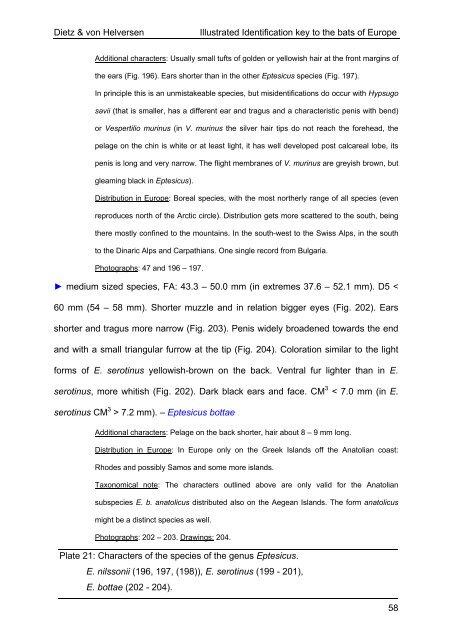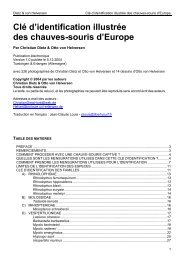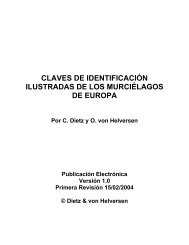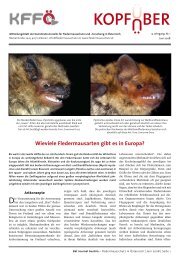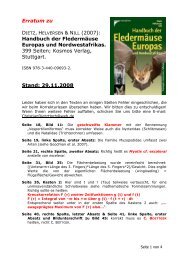Dietz & von Helversen Illustrated Identification key to the bats of ...
Dietz & von Helversen Illustrated Identification key to the bats of ...
Dietz & von Helversen Illustrated Identification key to the bats of ...
You also want an ePaper? Increase the reach of your titles
YUMPU automatically turns print PDFs into web optimized ePapers that Google loves.
<strong>Dietz</strong> & <strong>von</strong> <strong>Helversen</strong><strong>Illustrated</strong> <strong>Identification</strong> <strong>key</strong> <strong>to</strong> <strong>the</strong> <strong>bats</strong> <strong>of</strong> EuropeAdditional characters: Usually small tufts <strong>of</strong> golden or yellowish hair at <strong>the</strong> front margins <strong>of</strong><strong>the</strong> ears (Fig. 196). Ears shorter than in <strong>the</strong> o<strong>the</strong>r Eptesicus species (Fig. 197).In principle this is an unmistakeable species, but misidentifications do occur with Hypsugosavii (that is smaller, has a different ear and tragus and a characteristic penis with bend)or Vespertilio murinus (in V. murinus <strong>the</strong> silver hair tips do not reach <strong>the</strong> forehead, <strong>the</strong>pelage on <strong>the</strong> chin is white or at least light, it has well developed post calcareal lobe, itspenis is long and very narrow. The flight membranes <strong>of</strong> V. murinus are greyish brown, butgleaming black in Eptesicus).Distribution in Europe: Boreal species, with <strong>the</strong> most nor<strong>the</strong>rly range <strong>of</strong> all species (evenreproduces north <strong>of</strong> <strong>the</strong> Arctic circle). Distribution gets more scattered <strong>to</strong> <strong>the</strong> south, being<strong>the</strong>re mostly confined <strong>to</strong> <strong>the</strong> mountains. In <strong>the</strong> south-west <strong>to</strong> <strong>the</strong> Swiss Alps, in <strong>the</strong> south<strong>to</strong> <strong>the</strong> Dinaric Alps and Carpathians. One single record from Bulgaria.Pho<strong>to</strong>graphs: 47 and 196 – 197.► medium sized species, FA: 43.3 – 50.0 mm (in extremes 37.6 – 52.1 mm). D5 7.2 mm). – Eptesicus bottaeAdditional characters: Pelage on <strong>the</strong> back shorter, hair about 8 – 9 mm long.Distribution in Europe: In Europe only on <strong>the</strong> Greek Islands <strong>of</strong>f <strong>the</strong> Ana<strong>to</strong>lian coast:Rhodes and possibly Samos and some more islands.Taxonomical note: The characters outlined above are only valid for <strong>the</strong> Ana<strong>to</strong>liansubspecies E. b. ana<strong>to</strong>licus distributed also on <strong>the</strong> Aegean Islands. The form ana<strong>to</strong>licusmight be a distinct species as well.Pho<strong>to</strong>graphs: 202 – 203. Drawings: 204.Plate 21: Characters <strong>of</strong> <strong>the</strong> species <strong>of</strong> <strong>the</strong> genus Eptesicus.E. nilssonii (196, 197, (198)), E. serotinus (199 - 201),E. bottae (202 - 204).58


